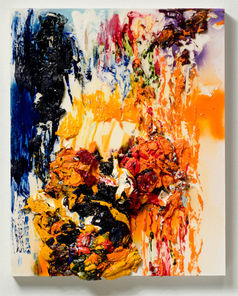STEVEN HAMPTON
Still Life
As one of the major traditional genres of painting, Still Life has been excessively classified (as well as having excessively classified), organized, and analyzed. In modern and contemporary times, this academic genre has been used to critique social values through the depiction of popular culture, such as the comic strip or soup can. My interest is in investing the genre’s compositional structures with feelings of anxiety, hysteria, and panic. Instead of using painting to represent depictions of our base objects of desire (as done in Pop Art), I ascribe painting with what I consider to be the general attitudes of the day. I take traditions from the Still Life genre in order to exaggerate changes in themes from different historical moments to the present. My intention is not to put the genre on trial, or to perform a critique of the medium. My interest is in the potential for extreme change in painting, and what that change can say when looked at in relationship to its history.
In looking at Still Life painting, my first interest is in exaggerating the theme of painting “material existence where nothing exceptional occurs.” A common compositional prompt used by traditional still life painters was to force, or plunge, the viewer’s attention downwards. This was believed to cause a humiliation of attention and self (viewer). I have literalized this “Fallen Vision” in the structure of the paint, as well as making associations to the paint having “blurred” any initial image. Here the “blur” takes place as a consequence of its being burdened/weighted.
I stress the almost anti-Albertian character of Still Life space by pairing it with the flat space of abstraction. Both are spaces centered more on the close proximity of the viewer’s body. My paintings threaten to enter the viewer’s space by appearing only moments from falling off the panel onto the floor.
Still Life’s intent to give the viewer clarified vision of the insignificant (mundane objects), in my case, turns into the paint itself becoming the object. To do this, I reference Caravaggio’s aesthetic of heaping, which obscures the particularity of individual forms and mass. However, I don’t believe any of the technical showmanship of the Still Life is lost. These paintings indulge in the myriad of facile depiction of lush texture and surface.
Lastly, in some Still Life paintings, the narrative space is bound by gesture (Chardin, for example). In these paintings, objects appear to have been moved or touched. In my paintings, the “gesture” becomes gravity itself, or to be more specific, the “gesture” in my paintings is the act of hanging the panel on the wall. With this motion, the paint “heaps,” and through the process of a very still course of movement, plunges downwards. The paint buckles from the surface while creating opulent textural events.
I imagine my paintings fulfilling the perspective logic of Cezanne’s Still Lifes. With the paint becoming the mundane object in need of a clarified vision, my gesture is to “flip the tables.” A “blurred” quality emerges from the burdened mass, which, because of its physical projection from the surface, engages the viewer in a very immediate bodily space. With the cumulative effect of the paintings hung together, there is a stillness present in the awareness of an unsettling activity about to take place – like the calm before the storm – as all the paintings threaten to break their promise of stillness by plummeting from the panel to the ground.







